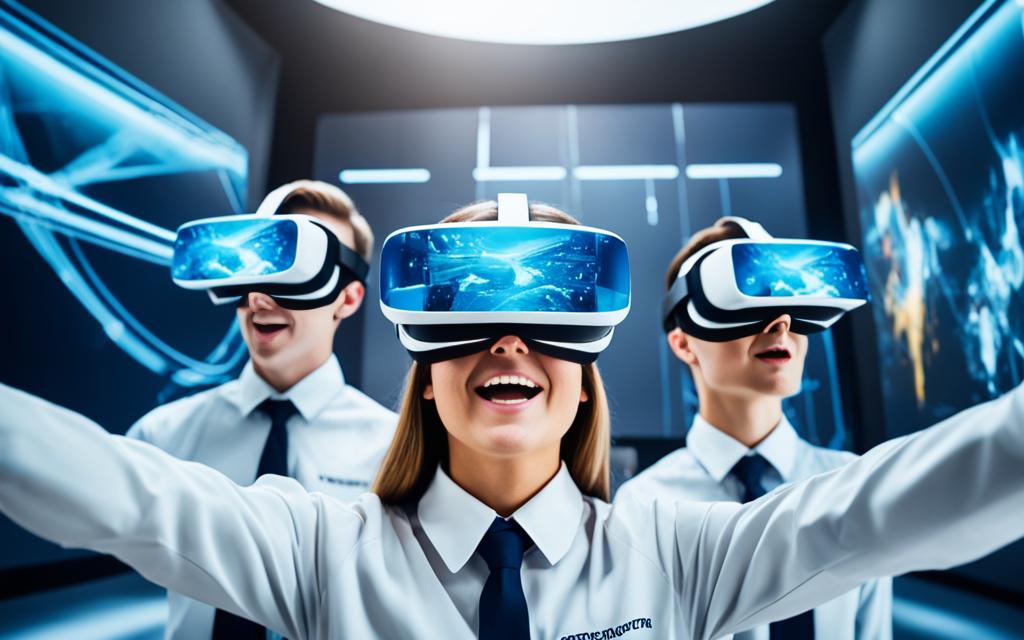New, high-tech tools are changing how we learn. They take students to far-off places in virtual reality and give them tailored lessons with adaptive AI-powered tutoring systems. These luxuries make learning more engaging and exciting.
There’s also gamification, e-learning platforms, and adaptive learning software making waves. Augmented reality turns books into living lessons. And online tools and educational robotics boost teamwork and fun in class.1
Discovery Education is at the movement’s heart. It offers AI in education and amazing edtech solutions. This means teaching and learning is more personal and effective than ever.2
Key Takeaways
- Immersive virtual reality experiences transport students to new worlds and enhance engagement.
- Adaptive AI-powered tutoring systems personalize lessons to individual student needs.
- Augmented reality brings textbooks and learning materials to life, fostering interactivity.
- Cutting-edge e-learning platforms and online collaboration tools revolutionize the classroom.
- Discovery Education is at the forefront of the education technology revolution, empowering educators and students.
Immersive Learning in Virtual Reality
Virtual reality (VR) is changing how we learn by putting students right in the middle of their lessons. They can walk around these 3D worlds and actually interact with the subjects. This makes learning more fun and easy to understand for everyone.
It’s like being in a video game but for learning. Imagine learning science by conducting experiments in a virtual lab or seeing old ruins up close. VR makes all of this possible.
Engaging Algebra Lessons Through Flight Simulations
Prisms VR is taking algebra to the skies. They’ve designed lessons where students control air traffic, plan flight routes, and solve problems to prevent crashes. These scenarios help students use math in real-life situations, making learning more interesting.
Basically, students get to tackle big problems in a safe, virtual world. This approach is proven to be more effective than just reading from a textbook.
Virtual Science Labs with Million-Dollar Equipment
3 In VR, students can create 3D art and designs. They can also use huge, expensive science equipment to conduct experiments. This is stuff they wouldn’t get to do in a regular classroom.
Creating a new way where students can deeply interact with the subject is key. It’s about making learning not just informative, but truly engaging and memorable.
Exploring Ancient Ruins and Natural Wonders
3 VR takes students on digital field trips. They can visit historical sites and see wonders of the natural world. This makes learning about history and science much more real and exciting.
Working together in these virtual worlds also helps build a virtual classroom community. It prepares students for teamwork, even in a digital environment.
3 VR is great for learning languages too. But, it’s expensive to get started and tricky to make good educational content for VR. Plus, safety and privacy in these virtual worlds are big concerns that we need to address.
Augmented Reality for Interactive Learning
Augmented reality (AR) is changing the game in education. Apps for AR, for smart devices, are changing how students see textbooks. They let students play with 3D objects and digital stuff right on their desks.4 With your phone or tablet, you’re all set for AR. There’s no need for extra gear, saving money.
Bringing Textbooks to Life
AR apps are making learning fun and interactive. They put digital things on top of textbooks and notes, letting students touch and see important points in 3D. This way, learning becomes like playing a game.5 Plus, it helps students who might learn differently by using sounds and touches to understand better.5motivates students because it feels like a fun game and less like work.5
Museum Exhibits in the Classroom
AR isn’t just for books. It can show you museum pieces and old ruins in your class. Special apps place these treasures right in front of you. You can look at them closely without travelling.6 Research shows AR is good for work lessons too, making training quicker and more fun. In Thailand, AR helped university students learn about 3D design easily.6
Reality crafted with digital magic makes learning awesome and open to everyone. It connects what you learn with how it’s used in the real world. This makes mastering new skills more natural.5 And, it encourages finding new ways to answer problems and learn, boosting creativity.5
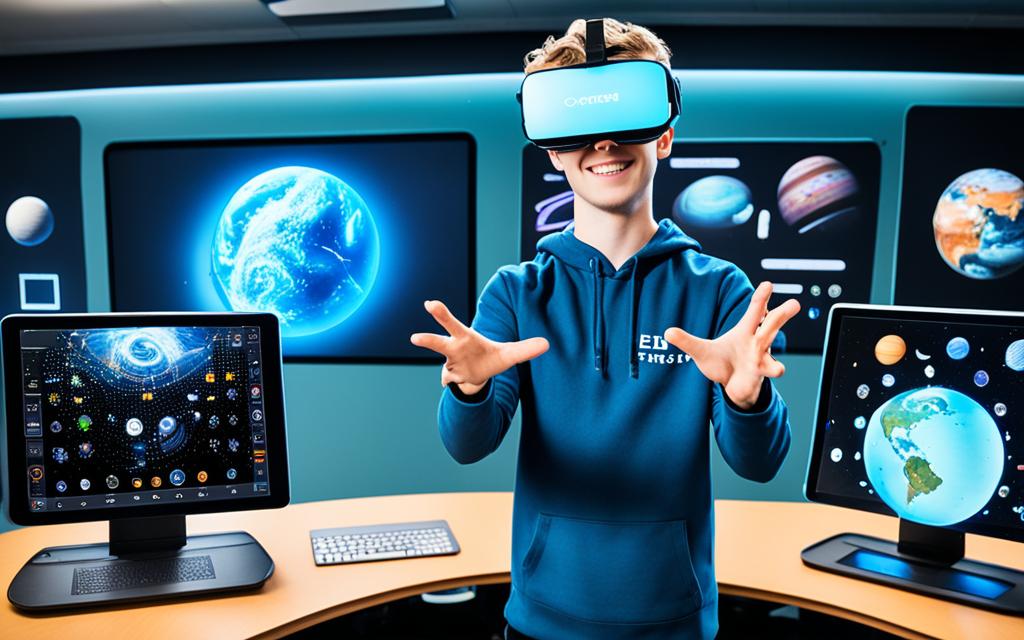
Innovations in Education Technology
Digital technologies have changed education a lot in the last 20 years.7 Now, technology is a must for learning. Students can visit ancient sites through VR and get special lessons from AI tutors.7
7 Big companies like Google and Facebook are putting a lot into VR for schools.7 AI helps with grading and teaching math and writing.7 Cloud computing lets students work together online. It also helps them get to resources from around the world.7 3D printing is changing how we learn, especially in making prototypes.
7 Schools also use social media to connect and share info.7 They are even starting to use things like face ID and fingerprints to keep track of students and their stuff.
8 Since 2015, there’s been a 145% growth in small companies making learning tools.8 Many believe AI will have a big effect on teaching in the next five years.8 The market for online classrooms could be worth $3.8 billion in a few years.
8 Games help people remember more, with a 27% boost over old-school teaching methods.
9 Education Technology Innovations (ETI) covers many areas.9 It includes people who are good at starting new businesses and raising money. Plus, they know how to run education groups.9
9 The College of Education at the University of Minnesota has been a leader for a century. Its teachers often start new fields.9 ETI joins up scientists with tech creators to make and share new gadgets. Flipgrid, for example, came from this kind of work.9
9 ETI makes software with the University of Minnesota. The team includes experts in different areas.9 They work fast using new ways to plan and make these programs.
Collaborative Virtual Spaces
The metaverse is the exciting future of the internet. It lets teachers and students gather in virtual places. This brings everyone together beyond the limits of our physical world.10 With virtual reality (VR) and other advanced tech, educators craft digital twin campuses. These are just like the real schools but in a digital form. So, students can join their classes, do labs, and meet friends, feeling like they’re actually there.10
Digital Twin Campuses
These digital twins are amazing for getting students to learn together online. They build a sense of community and make learning better.10 Students explore virtual rooms, labs, and hangout spots, just like in person. This lets them take part in lessons, chats, and practical tasks from far away.10
Remote Experiments and Simulations
Thanks to virtual reality in these twins, students get to try out labs and simulations safely online. Things that could be too risky, hard, wasteful, or costly in real life are now possible.10 This cool way of learning not only boosts how we learn but also lets students dive deep into tough scientific ideas.10
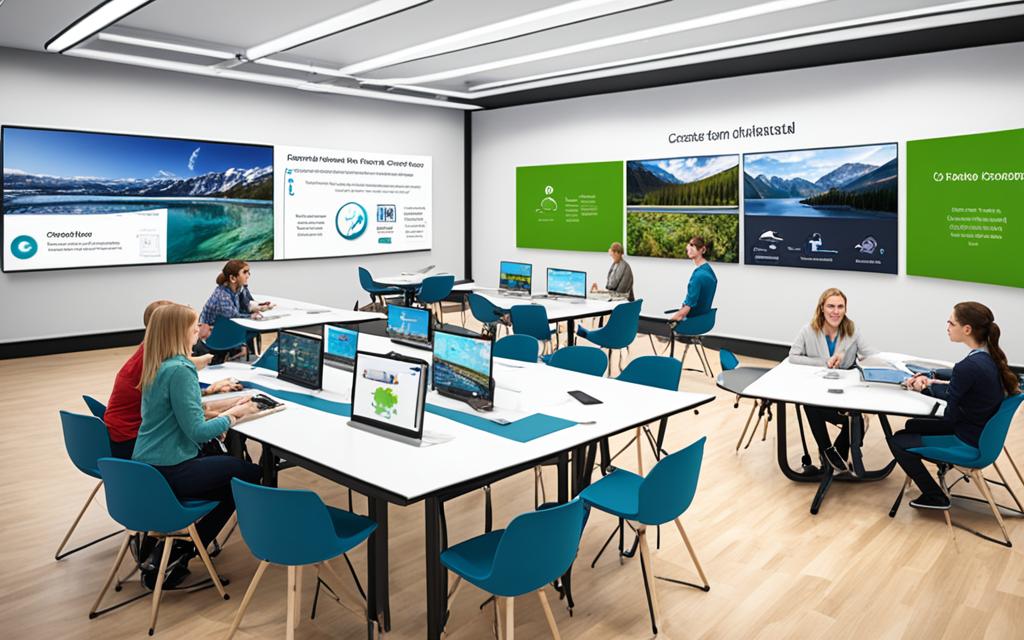
Personalized Learning with AI
Technologies such as virtual and augmented reality mix with AI to change how we learn.11 Before, education was set for everyone the same way. Now, AI can make each lesson fit a student’s specific needs and style.12
Adaptive Curriculum and Lesson Plans
13 In adaptive learning, AI tailors the content and tests just for you.13 It looks at your progress and how involved you are to set lessons that match. This makes sure you’re not bored or finding it too hard.
Thus, AI keeps learning interesting by changing things to match your level. It helps you get better without making you feel stuck.
Language Learning with Real-Time Feedback
12 AI in personalized learning brings lessons right to your needs. It changes how fast or slow you learn. And it gives tips as you go, helping you exactly where you need it.
12 As you learn, AI keeps up and gives more help or harder stuff if you need it. This way, everyone gets the right support. It also helps teachers see what works best with clear data.
11 A 2017 Gallup Poll shows active students learn more. So, personalized lessons and what keeps you interested go hand in hand.11 Using AI in class is new and needs teachers to be ready to adjust. They should learn about AI too, so they can guide you well in our fast-changing tech world.
The SAMR Model for Technology Integration
The SAMR model helps teachers integrate technology effectively. It was created by Ruben Puentedura in 2010.14 This model looks at four different levels of using technology to meet learning goals and tasks.14
Substitution: Digital Worksheets
Technology at the substitution level means not changing its use. For example, instead of paper worksheets, students get them digitally. This makes sharing, storing, and editing easier.14 It’s a good starting point for teachers new to tech use in the classroom.14
Augmentation: Enhanced Learning Materials
At the augmentation level, technology makes learning more interactive. Teachers can add links, videos, and instant feedback to lessons. This makes learning more fun and meaningful.14 Students get a richer experience from these digital enhancements.14
Modification: Redesigned Learning Activities
Technology at the modification level changes how students learn. It can help with group projects, digital portfolios, and fun quizzes. This makes the classroom experience very different from traditional teaching.14 Teachers use these new methods to get students more involved in learning.14
Redefinition: Transformative Learning Experiences
At the redefinition level, technology makes new learning possibilities. Think virtual trips to historical sites or AI that personalizes lessons. These approaches let students do things they couldn’t before.14 It opens the door for students to solve real issues in creative ways.14
Teachers should think about how to use tech to make learning better and more real.14 By using technology wisely, they can make education even more enjoyable and enriching.14
| SAMR Level | Description | Examples |
|---|---|---|
| Substitution | Technology acts as a direct tool substitute, with no functional change | Digital worksheets, online textbooks |
| Augmentation | Technology acts as a direct tool substitute, with functional improvements | Interactive digital materials, multimedia-enhanced lessons |
| Modification | Technology enables significant task redesign | Collaborative projects, digital portfolios, gamified assessments |
| Redefinition | Technology allows for the creation of new tasks, previously inconceivable | Virtual reality field trips, AI-powered personalized lessons |
The SAMR model is well known in educational tech circles. Many experts have looked into how it’s used and its benefits.15 While most agree it’s good for tech in the classroom, some have suggested updates.15 It’s been studied in relation to the TPACK framework and the impacts of COVID-19.15
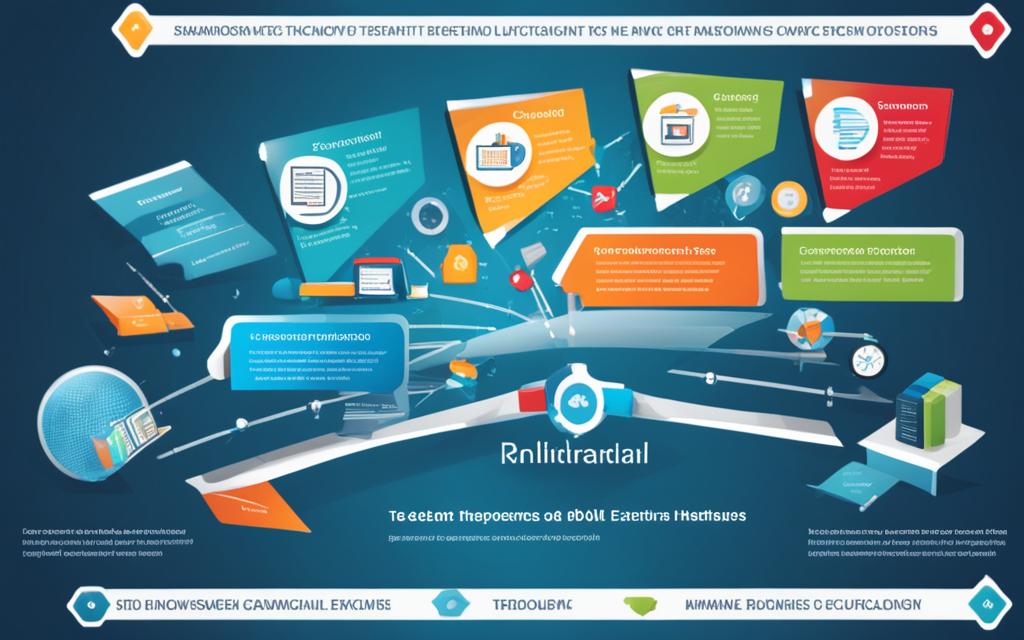
Nurturing Curiosity in the Classroom
Curiosity plays a big role in keeping students interested and involved. Technology in education is a strong way to spark curiosity and link students to the outside world.16
Real-World Connections and Virtual Field Trips
By using tools like virtual reality, teachers can create real-world experiences in the classroom. These tools make learning about historical places, nature, and complex experiments fun and engaging. Students get to see how the lesson connects to the real world.17
Engaging Resources from Industry Partners
Getting help from experts in different fields can add a lot to what students learn in class. This could be special talks or workshops from people who do real science or run businesses. It shows students how what they learn is used in the real world, motivating them to follow their interests.1617
By using technology and connecting with experts, teachers can make the learning process exciting and lasting. It makes students eager to learn more even after they leave the classroom.1617
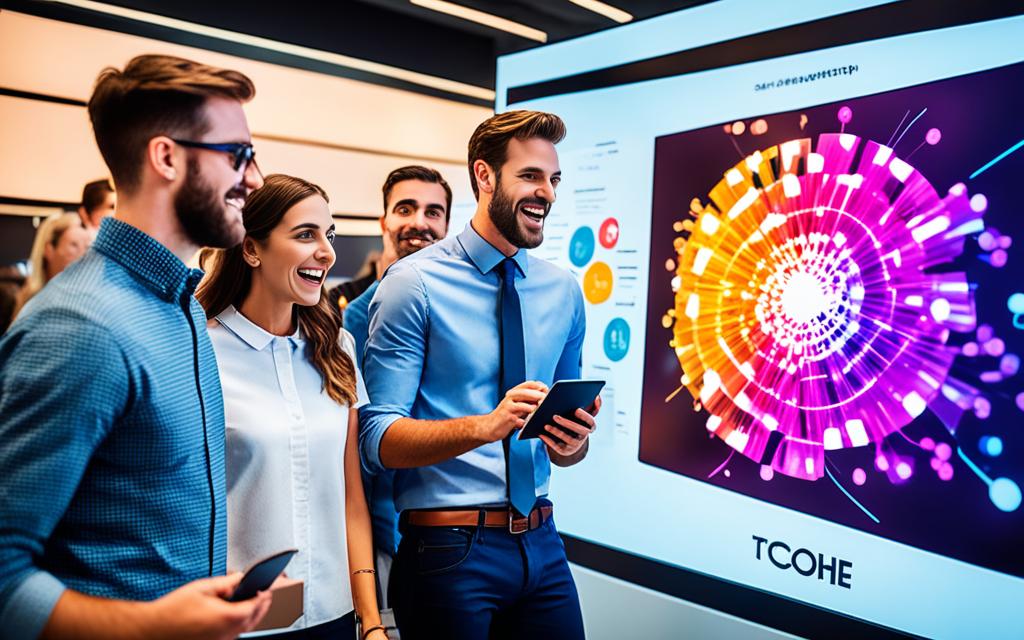
Educator Support and Professional Development
Helping teachers use educational technology well needs constant help and learning. Discovery Education knows how vital it is to make sure teachers can use new tools easily. They aim to make learning fun for students using these tools.18
Collaborative Learning Communities
Discovery Education creates collaborative learning communities to connect teachers. Here, teachers can share what works, swap ideas, and learn from their peers.19 These networks keep educators updated on the newest education technology. This way, they provide the best lessons possible.18
On-Demand Training and Guides
Discovery Education doesn’t just hold face-to-face training. They also offer many on-demand training tools and instructional guides.18 These resources talk about many topics, like using virtual reality in school or adaptive learning software for each student’s needs.18
Discovery Education gives teachers the tools and know-how to use education technology well. This change is key in creating a better classroom environment. It also helps students get ready for the future.18
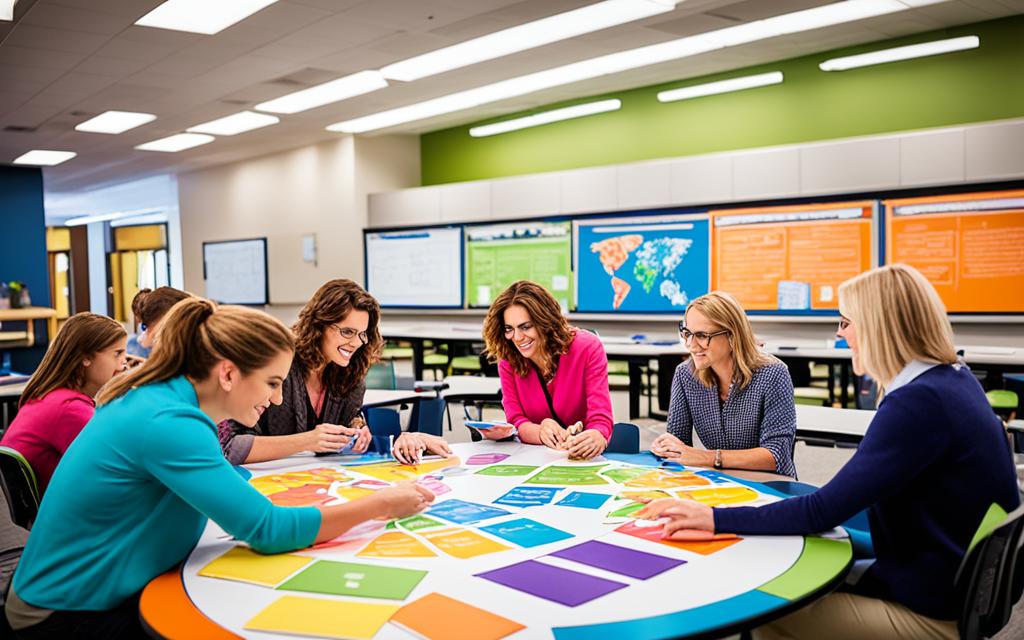
Success Stories and Impact
The impact of education technology is clear from the success stories of schools and districts. They have seen great results since they started using advanced edtech solutions. Discovery Education, for example, has worked with many schools to introduce these innovations.
Case Studies and Testimonials
Boise State University’s Master of Educational Technology (MET) program has greatly helped its students.20 100% of the students interviewed said it benefitted their careers. These students came from various fields like teaching, finance, and business.20 After completing the program, they were able to work in different EdTech roles.20
Students felt that Boise State gave them the skills and knowledge needed in the EdTech sector.20 Examples of jobs they landed include Interactive Learning Designer and Online Course Manager.20 The program has also helped students move into management and instructional design roles in the education industry.20
This program focuses on teaching students how to develop curriculum and design education. It has prepared students for challenges in educational technology and the use of advanced tech like AI.20
Efficacy Research and Awards
The impact of education technology isn’t just seen in stories. 3D printing, for example, creates hands-on models for learning.21 Virtual reality takes students on virtual field trips to boost engagement.21 Using games in class helps keep students interested and gives instant feedback on their learning.21
On top of that,21 cloud technology connects students and teachers. It also stores educational content. AI automates grading and offers insights into learning patterns.21 Mobile apps provide personalized learning opportunities.21 It’s crucial to carefully choose and balance new technologies with traditional teaching methods for a comprehensive education.21
The effect of edtech goes beyond just stories.22 Back in 2011, an 11-year-old aced a college-level physics course using online resources. This highlighted the potential of tech in education.22 During the Great Recession, the education industry lost over a million jobs, showing the impact on employment.22 American students spend less time in school than those in many other nations, which poses a challenge.22
Advances in assessment tech are key in giving teachers and policymakers quick feedback.22 A report showcases how innovations like language teaching robots improve efficiency in education.22
Conclusion
The world of education is changing fast thanks to education technology. Teachers now have powerful tools to make learning fun and tailor it to each student.23 These include virtual reality that makes lessons real and AI that personalizes learning.
Technology is also tearing down distance and wealth barriers in education.24 It gives all students, no matter where they are or how much money they have, a chance. Online courses let you learn when you can and how you want.24 Special apps and platforms help students who learn in different ways, making learning more inclusive.
The way we learn is not done changing. Education technology will keep getting better, making a big difference.25 It’s teaching kids skills they need for now and the future, like thinking critically and working with others.24 With technology in every classroom, the future of education will be exciting and personal for everyone.
FAQ
What are the latest innovations in education technology?
How is virtual reality (VR) being used in education?
What role does augmented reality (AR) play in education?
How are collaborative virtual spaces changing the learning environment?
How is artificial intelligence (AI) improving personalized learning?
What is the SAMR model, and how does it help evaluate technology integration in education?
How can education technology help nurture curiosity in the classroom?
What kind of support and professional development do teachers need to effectively integrate education technology?
What are some success stories and impact of education technology?
Source Links
- https://itif.org/publications/2021/08/30/promise-immersive-learning-augmented-and-virtual-reality-potential/
- https://www.discoveryeducation.com/
- https://medium.com/@astomverse/transforming-education-with-virtual-reality-a-gateway-to-immersive-learning-7b54096287be
- https://arborxr.com/blog/augmented-reality-in-education-examples-benefits-use-cases/
- https://www.webanywhere.com/2024/02/05/augmented-reality-in-online-learning-transforming-education/
- https://files.eric.ed.gov/fulltext/EJ1306555.pdf
- https://www.theamegroup.com/top-6-technology-innovations-education/
- https://meetaverse.com/blog/top-innovations-in-education/
- https://eti.umn.edu/
- https://www.frontiersin.org/articles/10.3389/frvir.2023.1159905
- https://www.edsurge.com/news/2023-08-14-a-new-way-to-personalize-learning-thanks-to-ai
- https://www.thinkful.com/blog/ai-and-education-personalized-learning-and-adaptive-curriculum/
- https://hyperspace.mv/personalized-learning-2/
- https://www.edutopia.org/article/powerful-model-understanding-good-tech-integration/
- https://taylorinstitute.ucalgary.ca/resources/SAMR-TPACK
- https://www.waldenu.edu/online-masters-programs/ms-in-education/resource/teaching-strategies-sparking-curiosity-in-learning
- https://www.learnandplaymontessori.com/blog/nurturing-curiosity-and-innovation-exploring-stem-in-montessori-education/
- https://www.learninga-z.com/site/resources/breakroom-blog/professional-development-support
- https://blogs.worldbank.org/en/education/how-enhance-teacher-professional-development-through-technology-takeaways-innovations
- https://www.boisestate.edu/education-edtech/student-success-stories/
- https://www.classcraft.com/blog/examples-of-educational-technology/
- https://www.brookings.edu/articles/education-technology-success-stories/
- https://www.thepolicycircle.org/brief/innovation/
- https://www.eschoolnews.com/it-leadership/2023/12/11/the-impact-of-technology-on-education/
- https://www.educause.edu/ecar/research-publications/ecar-study-of-undergraduate-students-and-information-technology/2018/conclusion-and-recommendations
